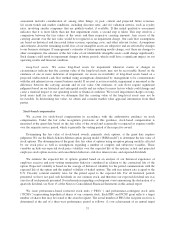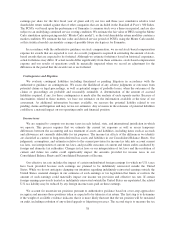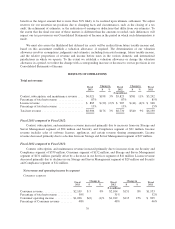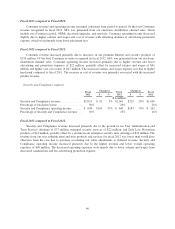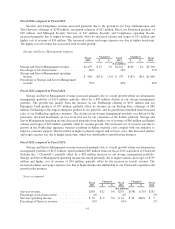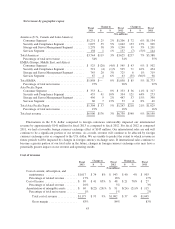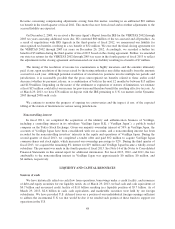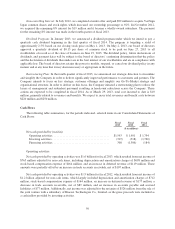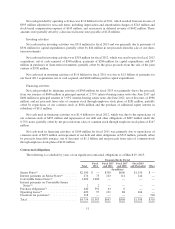Symantec 2013 Annual Report Download - page 145
Download and view the complete annual report
Please find page 145 of the 2013 Symantec annual report below. You can navigate through the pages in the report by either clicking on the pages listed below, or by using the keyword search tool below to find specific information within the annual report.research credit for the fourth quarter of fiscal 2012 resulting from the extension of the federal research credit as
part of the 2012 Taxpayer Relief Act. These tax benefits were offset by a $9 million tax expense from an increase
in valuation allowance on state research tax credits.
The tax expense in fiscal 2012 was reduced by the following benefits: (1) $52 million tax benefit arising
from the VERITAS 2002 through 2005 IRS Appeals matters, (2) $14 million from lapses of statutes of limitation,
(3) $17 million from the settlements and effective settlements with tax authorities and related remeasurements,
and (4) $5 million tax benefit from adjustments related to prior year items. This benefit was partially offset by a
$5 million tax expense resulting from a change in valuation allowance for certain deferred tax assets.
The tax expense in fiscal 2011 was reduced by the following benefits: (1) $49 million arising from the
VERITAS v Commissioner Tax Court decision further discussed below, (2) $15 million from the reduction of our
valuation allowance for certain deferred tax assets, and (3) $21 million tax benefit from lapses of statutes of
limitation, and (4) $7 million tax benefit from the conclusion of U.S. and foreign audits.
The effective tax rate for all periods presented otherwise reflects the benefits of lower-taxed international
earnings and losses from our joint venture with Huawei Technologies Co., Limited, domestic manufacturing
incentives, and research and development credits, partially offset by state income taxes. Pretax income from
international operations was significantly higher in fiscal 2012 due to the sale of our 49% ownership interest in
the joint venture to Huawei on March 30, 2012 for $526 million. A significant portion of the sale proceeds was
attributable to international tax jurisdictions resulting in a 20% tax rate on the sale of the joint venture reducing
the overall tax rate in fiscal 2012 by 3%.
We are a U.S.-based multinational company subject to tax in multiple U.S. and international tax
jurisdictions. A substantial portion of our international earnings were generated from subsidiaries organized in
Ireland and Singapore. Our results of operations would be adversely affected to the extent that our geographical
mix of income becomes more weighted toward jurisdictions with higher tax rates and would be favorably
affected to the extent the relative geographic mix shifts to lower tax jurisdictions. Any change in our mix of
earnings is dependent upon many factors and is therefore difficult to predict.
For further information on the impact of foreign earnings on our effective tax rate, see Note 12 of the Notes
to Consolidated Financial Statements.
See Critical Accounting Estimates above for additional information about our provision for income taxes.
In assessing the ability to realize our deferred tax assets, we considered whether it was more likely than not
that some portion or all of the deferred tax assets will not be realized. We considered the following: we have
historical cumulative book income, as measured by the current and prior two years, we have strong, consistent
taxpaying history, we have substantial U.S. federal income tax carryback potential; and we have substantial
amounts of scheduled future reversals of taxable temporary differences from our deferred tax liabilities. Levels of
future taxable income are subject to the various risks and uncertainties discussed in Part I, Item 1A, Risk Factors,
set forth in this annual report. We have concluded that this positive evidence outweighs the negative evidence
and, thus, that the deferred tax assets as of March 29, 2013 of $402 million, after application of the valuation
allowances described above, are realizable on a “more likely than not” basis.
On December 10, 2009, the U.S. Tax Court issued its opinion in VERITAS v. Commissioner, finding that
our transfer pricing methodology, with appropriate adjustments, was the best method for assessing the value of
the transaction at issue between VERITAS and its international subsidiary in the 2000 to 2001 tax years. In June
2010, we reached an agreement with the IRS concerning the amount of the adjustment based on the U.S. Tax
Court decision. As a result of the agreement, we reduced our liability for unrecognized tax benefits, resulting in a
$39 million tax benefit in the first quarter of fiscal 2011. In March 2011, we reached agreement with Irish
47


